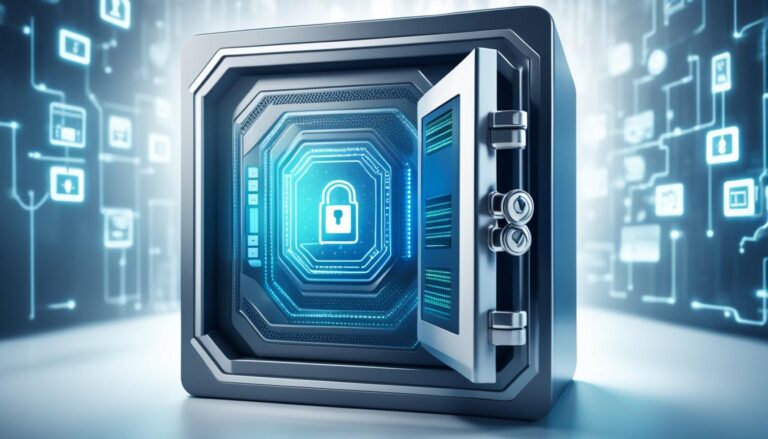Phishing, among the most prevalent cybercrimes, imperils individuals using deceptive emails, texts, and social media communications. It menaces online safety and personal data. Cybercriminals manipulate with calls to action, threats, and a false sense of urgency. They aim to extract sensitive information, affecting millions annually.
The prospect of your personal details in the wrong hands brings forth potential identity theft, financial jeopardy, and harm to reputation. Vigilance against phishing is critical to your defense.
Key Takeaways:
- Phishing scams are a common and dangerous form of cybercrime that targets individuals through deceptive emails, text messages, and social media direct messages.
- Cybercriminals use various manipulative tactics to trick people into revealing their sensitive data, posing a significant threat to online security and personal information.
- Being able to recognize the signs of a phishing email, such as urgent calls to action, spelling errors, and suspicious links, is crucial in protecting yourself from falling victim to these scams.
- Avoid clicking on suspicious links or attachments, and report phishing emails to help improve filters and protect others.
- By staying informed and following best practices for online security, you can mitigate the risks associated with phishing attacks and safeguard your personal information.
How to Protect Yourself from Phishing Attacks
Shielding yourself from phishing scams and email fraud is essential for online safety. It helps combat identity theft and ward off cyber attacks. By adhering to key steps, you can bolster your defenses against malicious spam emails.
Recognizing Phishing Emails
A critical step in defense is spotting phishing emails. These messages often start with generic salutations, contain unrequested content, and might feature typos. They illegally solicit personal details best not shared via email.
Spam emails can harbor dubious links or files. Always resist the urge to click on them. Doing so could introduce malware or open paths for other digital threats.
Reporting Suspicious Messages
Encountered a suspicious email? It’s vital to flag it. Notifying your email service provider can enhance their email monitoring, aiding others in sidestepping phishing bait.
Given the grave threat of identity theft, it’s equally crucial to inform the authorities. Contact reputable groups like the Anti-Phishing Working Group or the Federal Trade Commission. They can act to curb such nefarious schemes.
Protecting Your Personal Information
Never share sensitive data over email, as trusted sources won’t request this. Keeping this rule helps defend against cyber attacks. Employing robust passwords and periodic changes is another bulwark.
Enabling multi-factor authentication fortifies your safeguards. This extra step can thwart unauthorized access to your accounts.
Keeping Software Up to Date
Ensuring your system and browser are current prevents security gaps. Updates are vital, containing fixes for potential exploits. Cybercriminals target those running outdated software.
Backup Data and Use Firewalls and Antivirus Software
Regular backups defend your data integrity against attacks. They provide a pathway for recovery if disaster strikes. This simple tactic can save you from heavy losses.
Firewalls act as sentinels against unwelcome intrusions. Pair this with strong antivirus protection. It’s a powerful combo to detect and cleanse your devices of digital threats.
Adhering to these best practices for online security lowers your risk against phishing and cyber attacks. Always be alert, keeping your personal data and interaction with emails under a keen eye.
Avoid responding to suspicious messages
| Best Practices to Protect Against Phishing Attacks |
|---|
| Recognize the signs of phishing emails |
| Report phishing emails to your email provider |
| Avoid sharing personal information over email |
| Keep your software up to date |
| Enable multi-factor authentication |
| Regularly back up your data |
| Use firewalls and antivirus software |
How to Recognize Phishing Emails
Understanding phishing emails is key to avoiding phishing scams and email fraud. You should learn the common signs and stay alert. Through this, you can steer clear of cyber attacks and spam emails.
Warning Signs of Phishing Emails
Phishing emails stand out with specific traits. These signs can tip you off:
- Unfamiliar Greetings or Tones: They often start with generic greetings or out-of-place tones.
- Unsolicited Messages: Be wary of unexpected emails, especially from unknown sources.
- Grammar and Spelling Errors: Noticeable mistakes in their grammar or spelling can be a tell-tale sign.
- Sense of Urgency: Urgency aims to push you into immediate actions, such as clicking on a harmful link.
- Suspicious Links or Attachments: Be careful with links or files you’re urged to click, as they can hide threats.
- Requests for Personal Information: They might ask for sensitive data like your password or financial details.
- Inconsistencies in Email Addresses: Misleading but similar email addresses can be a hint of malicious intent.
- Unusual Requests: Watch out for odd demands, for instance, asking for money without clear reason.
Phishing emails often play on urgency or lure with rewards to lure you into clicking harmful links or sharing personal info. Be extra careful with emails from reputed institutions like banks or government agencies. They are prime targets for phishing scams.
Always double-check an email’s legitimacy before acting. Listen to your gut and be wary of any questionable emails.
Staying informed on phishing scams, email fraud, and cyber attacks is essential for keeping your online presence secure.
Phishing Email Examples:
What to Do if You Suspect a Phishing Attack
When you suspect a phishing attack, quick action is key to safeguarding your personal data. By knowing what steps to take, you reduce your risk of becoming a phishing scam victim. Immediate responses can prevent further cyber threats.
1. Do Not Respond or Engage
Seeing a suspicious email demands caution. Don’t reply or click any links within it. Malware may lurk in unsuspecting attachments or websites, ready to steal your data.
2. Report the Suspicious Email
Alert your email service about the suspicious email. Most providers offer tools for marking it as spam or phishing. This helps them spot and block future similar emails.
3. Contact Relevant Authorities
Forward the email to the authorities, like the Anti-Phishing Working Group (https://www.antiphishing.org/report-phishing/) or the Federal Trade Commission (https://www.ftc.gov/complaint). They work to stop phishing by investigating and taking legal action.
4. Avoid Sharing Personal Information
Never disclose personal or sensitive data to emails or websites of doubtful nature. Phishing emails aim to get your private information, like passwords or credit card details. Protect yourself by guarding your personal data.
5. Verify Legitimacy by Direct Contact
If an email seems genuine but is from a possibly fake source, don’t directly respond. Confirm its legitimacy through known contact details of the sender. This ensures you’re dealing with the real organization.
6. Update Account Passwords
If you did share your login details mistakenly, change your passwords without delay. This action bars unauthorized entry and secures your sensitive data further.
7. Inform Financial Institutions
If you fear a breach in your financial accounts, alert your bank or financial service at once. They can halt fraudulent activities and secure your money.
8. Monitor Your Online Accounts
Post a phishing scare, keep a close eye on your online activities and financial papers. Watch for any unexpected transactions or setting changes. Vigilance helps quickly spot and counteract security threats.
These steps empower you to combat phishing attacks effectively. Staying ahead in online security is crucial for protecting your personal data and ensuring a safe digital experience.
Image Alt Text: phishing scams
How to Report Phishing
Reporting phishing emails is vital in the fight against scams and safeguarding people. Each email provider offers its own way to report these messages. In Gmail, you’d click the three-dot icon and select “Report phishing.” Within Outlook, simply label the email as a phishing attempt.
This action helps improve email filters and bar similar attacks on others. You contribute to a safer online world by notifying your email service of malicious emails.
Aside from your provider, you can inform specialized groups like the Anti-Phishing Working Group or the Federal Trade Commission. These bodies investigate the reported emails and take legal steps against the scammers. Your report aids in a wider fight against cyber assaults, making the internet a more secure place for all users.
Delete these emails from your inbox to shield yourself from future dangers. An empty inbox of suspicious items is a first line of defense online. Stay alert and report any emails that strike you as shady to lessen the threat of phishing.
Reporting Phishing Emails
| Email Provider | Reporting Method |
|---|---|
| Gmail | Select “Report phishing” from the three-dot menu |
| Outlook | Mark the email as phishing |
Reporting suspicious emails to both your email host and the appropriate entities is key to a unified front against phishing. Be proactive in flagging these threats to protect your online community.
Phishing Protection Tips and Best Practices
To bolster your defense against phishing attacks, it’s crucial to heed several key practices. By learning to spot phishing emails and taking steps to protect yourself, the risk of being scammed drops significantly.
Recognize the Signs of Phishing Emails
Phishing emails often look real but carry a hidden agenda. They might greet you oddly, seem out of the blue, have spelling errors, or contain risky links/attachments. If an email feels off or requests personal info, be cautious.
Avoid Responding to Phishing Emails
When a phishing email lands in your inbox, refraining from interacting with it is wise. Clicking on links or responding can alert scammers that your address is live, risking more attacks. Instead, let your email provider know about the fishy email.
Use Strong Passwords and Enable Multi-Factor Authentication
Guard your online accounts with robust, distinct passwords. Steer clear of easily guessable ones like ‘password123.’ A password manager can assist in keeping them safe.
Also, where possible, set up multi-factor authentication. It adds an extra step to sign in, such as a code texted to you, further shielding your accounts.
Keep Your Operating System and Web Browser Up to Date
Staying current on your operating system and browser is vital for security. Updates often mend security gaps, shielding your devices and data from online threats.
Regularly Back Up Your Data
Backing up your data safeguards against data loss in cyber-attacks or accidents. Use an external drive or cloud service for your backups, ensuring your files are always within reach.
Be Cautious of Pop-Ups and Use a Firewall
Pop-ups asking for personal details or software downloads can signal danger. Genuine sites seldom use pop-ups in this manner. Employing a firewall deters unwanted network access, bolstering your defense against phishing.
Use Antivirus Software
Antivirus software is a shield against viruses and other cyber threats. Keep it up-to-date for peak performance in identifying and eliminating dangerous software.
By adopting these guidelines, you can lower the chance of falling for phishing attacks and boost your digital safety.

The Dangers of Phishing Scams: Protecting Your Information
In the digital era, phishing scams and email fraud are widespread. They present significant threats to both individuals and businesses. Their goal is to fool people into giving away personal data like passwords and financial details.
Falling for a phishing scheme can lead to many problems. It can cause financial harm, open the door to account breaches, and harm one’s reputation. Identity theft is a major risk, with criminals using your data for illegal activities.
To protect yourself, safeguard your personal data closely. Be wary of who you share sensitive info with online. Only trust reputable sources. Confirm the authenticity of emails and websites before sharing personal information. Watch out for any suspicious red flags.
Adopting sound online security measures is crucial in the fight against phishing. Always use strong, different passwords and consider multi-factor authentication. Keep your system and software updated for the latest security fixes.
It’s also important to stay updated on the newest phishing scams. Keep informed about cybersecurity through reliable sources. Learning the common tactics of cybercriminals makes you better prepared to defend against their tricks.
Ways to Protect Your Personal Information:
- Never share sensitive information via email or on unsecured websites.
- Verify the legitimacy of emails and sender before providing any personal information.
- Use strong, unique passwords and enable multi-factor authentication.
- Regularly update your operating system and software.
- Be cautious of suspicious links and attachments.
- Stay informed about the latest phishing scams and techniques.
Ensuring the safety of your personal data is key in avoiding phishing perils. By staying alert and informed, you can establish a strong defense against cyber threats. Protecting your information helps protect you from online dangers.
The Importance of Cybersecurity Awareness in Phishing Prevention
Protecting ourselves from phishing scams and cyber attacks starts with cybersecurity awareness. Understanding the signs of phishing emails and best practices for online security is crucial. Also, knowing how to report and handle suspected phishing attempts can reduce our risk.
It’s important to stay updated on the newest phishing techniques and have regular training. This keeps our vigilance sharp and our knowledge current. With the right information, spotting phishing attempts becomes easier, helping us avoid email fraud.
Creating a culture of cybersecurity awareness in workplaces and schools is vital. It empowers everyone with the skills to prevent phishing attacks. This action boosts our protection against cyber threats.
Phishing scams and email fraud are ongoing risks. Through prioritizing cybersecurity awareness and taking preventive actions, we can safeguard our digital identities. Together, we can actively defend against phishing scams and cyber attacks.
How Phishing Impacts Individuals and Organizations
Phishing attacks wreak havoc on people and entities alike. These insidious online scams, often masquerading as trustworthy emails, trick individuals into sharing their confidential details. The fallout is often severe.
The Impact on Individuals
For those who fall prey to phishing, the effects can be profound. They might suffer financial losses should their banking or card details end up in the wrong hands. Moreover, there’s the specter of identity theft, where personal information is weaponized, causing mayhem in one’s personal and professional life.
Such scams puncture our online defenses, potentially opening the door for hackers to infiltrate accounts, lift sensitive data, and even commit fraud. Addressing the aftermath of an attack can involve a complex and drawn-out process, engaging various financial, regulatory, and legal entities.
Guarding against such threats means being educated about scam tactics and staying alert for suspicious communications. With the right knowledge and a proactive stance on security, individuals can shield themselves from these malicious schemes.
The Impact on Organizations
Phishing does not spare organizations, offering hackers a way into their systems. The fallout, including financial depletion, loss of trust, and legal repercussions, can be catastrophic if delicate information is breached.
For businesses, the risks are even greater. The theft of customer data, intellectual property, or the compromise of internal systems can initiate a cascade of financial woes. This might involve hefty investigation costs, litigations, and subsequent settlements.
Staving off phishing against the corporate world demands an integrated strategy. This approach encompasses technological defenses, like robust firewalls, ongoing employee training, and a steadfast commitment to staying abreast of evolving phishing methods.
Protection Against Phishing
Combatting these threats necessitates a firm resolve from all quarters. Champions—both individual and organizational—must band together, sharing knowledge, and deploying a variety of security measures to thwart these attacks.
The main points for protection encompass:
- Fortifying digital perimeters with advanced security protocols.
- Running consistent education sessions to enlighten about the latest in phishing.
- Inciting a culture where suspicious emails are promptly reported and acted on.
- Enforcing stringent password regulations and the use of multi-factor verification.
- Keeping systems and software updated with the newest security patches.
By embracing these measures, both individuals and companies can significantly elevate their defenses against phishing, safeguarding their confidential information and digital assets.
| Impact | Individuals | Organizations |
|---|---|---|
| Financial Loss | Loss of personal funds through compromised banking and credit card information. | Cost of investigating and resolving breaches, potential lawsuits and settlements. |
| Identity Theft | Potential damage to personal and professional reputation. | Compromised customer trust and reputation damage. |
| Security Vulnerabilities | Unauthorized access to personal accounts and private information. | Intellectual property theft and compromised internal systems. |
Note: The table above highlights the impact of phishing attacks on individuals and organizations.
Confronting phishing necessitates a unified front, with a commitment to knowledge-sharing, proactive countermeasures, and the prioritization of cybersecurity. By outsmarting online criminals, we erect strong defenses against the ruinous impacts of phishing scams.

Conclusion
It’s crucial to protect yourself from phishing scams for online security and to avoid identity theft. By learning to spot phishing emails and not responding to them, you can lessen the chances of being attacked. It’s also important to report any suspicious emails quickly.
Enhance your protection by following solid security practices. This includes using strong passwords and turning on multi-factor authentication. Keeping your software updated will also help fight against phishing. Being informed about the latest phishing trends and promoting cyber security awareness are crucial steps.
Your role in keeping your personal information safe from cybercriminals is critical. Stay alert against phishing scams and take preventive measures. This not only protects you but also helps in creating a safer online community for all.



